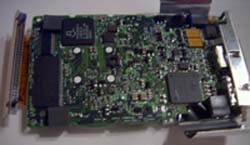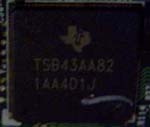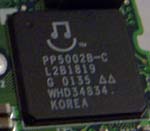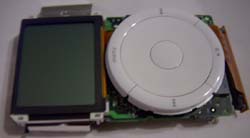The Dissection Continued
Removing the hard drive allows us to get a look at the heart of the iPod: it's system board.
Three chips on the PCB stick out. The first of these chips is the large rectangular chip located in the back end of the PCB. This is the iPod's memory, where it stores buffered song information. Made by Samsung, the chip's markings show it to be a 32MB SDRAM chip capable of operating at 100MHz.

Image courtesy iPoding
The second large chip on the board is located at the top of the unit, almost directly behind the firewire port. As you can imagine, this chip is the IEEE-1394a controller used by the iPod. The chip used, model number TSB43AA82, is made by Texas Instruments and is your standard firewire controller chip.
The final noteworthy item on the iPod's PCB actually turns out to be the unit's CPU. The chip is a PP5002B-C chip made by PortalPlayer. Although the specifications of the version of the chip used in the iPod are not available on PortyalPlayer's website, specifications on their P5001 controller are available. Bearing the similar product names, we can speculate that not much has changed in the Apple specific chip. If this is in fact the case, then the PP5002B chip has a ARM7 TDMI based core with a coprocessor dedicated to real time encoding acceleration. The processor is able to not only decode MP3 and wma files (note that the iPod's chip can decode MP3 files up to 320 Kbps, MP3 variable bit rate, WAV, and AIFF files), it is also able to encode on the fly (a feature which Apple did not take advantage of in the iPod). The chip also features an integrated 32KB of SRAM and 8KB of cache. We are unsure of the operating frequency of the chip or how many MIPS the chip can handle, but the iPod never functioned slowly suggesting that there is plenty of power.
The rear of the PCB (front of the iPod) houses no major chips. The LCD sits on the upper half of the PCB, while the iPod's controls are mounted directly to the bottom of the board. .
After a bit of disassembly, it is clear that the iPod's beauty is more than skin deep.














2 Comments
View All Comments
tipoo - Wednesday, January 12, 2011 - link
First. On an article from 2002. Muahaha.Saeed A. - Wednesday, October 17, 2012 - link
خسته نشی !!!